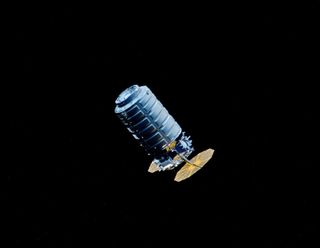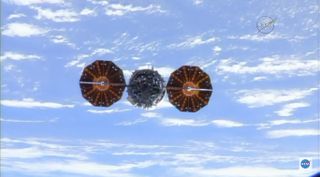Private Cygnus Cargo Ship Leaves Space Station to Spark Zero-G Fire

A privately built Cygnus cargo ship left the International Space Station Sunday (June 4) to cap a successful delivery mission for NASA with a novel experiment: igniting a fire in weightlessness.
The Orbital ATK-built Cygnus spacecraft was released into space via robotic arm by NASA astronaut Jack Fischer at 9:10 a.m. EDT (1310 GMT) as both cargo ship and station sailed 250 miles (402 kilometers) above the southern Atlantic Ocean. The automated Cygnus, called the S.S. John Glenn in honor of the late Mercury astronaut John Glenn, delivered 7,600 lbs. (3,500 kilograms) of NASA supplies to the station in April.
"Godspeed and fair landings, S.S. John Glenn," Fischer said as the spacecraft pulled away from the space station. "It has been an honor." [Relive the Cygnus S.S. John Glenn's Launch]
While Sunday's station departure ended Cygnus' primary resupply mission, the spacecraft still has some science to do before it is disposed of on June 11 by being intentionally burned up in Earth's atmosphere.
Chief among that science is NASA's SAFFIRE III, a fire-in-space experiment designed to test how large-scale fires behave in weightlessness. It is the third and final test in the first phase of flame experiments in space, NASA officials said. Two other SAFFIRE experiments were performed on earlier Cygnus flights in 2016.
"As the first chance to actually study a realistically scaled fire, the SAFFIRE experiments have provided valuable insight into fire behavior inside a confined low-gravity environment," SAFFIRE principal investigator David Urban said in a statement.
During the SAFFIRE III fire experiment, a large piece of fabric will be set ablaze inside Cygnus, where the oxygen level will be similar to that of the space station. Scientists will measure how the flame spreads at different rates of airflow, NASA officials said. The actual burn event will last about 20 minutes, with the experiment itself running 2.5 hours, they added.
Get the Space.com Newsletter
Breaking space news, the latest updates on rocket launches, skywatching events and more!
Over the next week, video and data from the fire experiment will be beamed to scientists on Earth ahead of Cygnus' fiery re-entry on June 11. NASA will use the data collected from the space fire test to designed safer spacecraft environments for astronauts in space.
New SAFFIRE space fire experiments are expected to launch in 2019, NASA officials said.
"SAFFIRE IV-VI will extend the research by including larger, more energetic fires and by testing post-fire cleanup systems," Urban said.

And once the space fire experiment is over, Cygnus still has more work to do. On Thursday (June 8), the spacecraft will deploy four small Lemur-2 cubesat satellites for Spire Global in a flight arranged by the company Nanoracks.
"The Nanoracks Lemur 2 satellites are part of a remote sensing satellite constellation that provide global ship traffic and weather monitoring," NASA spokesman Isidro Reyna said during live TV commentary.
Orbital ATK's S.S. John Glenn mission is thecompany's seventh Cygnus cargo flight for NASA under a commercial resupply contract. It's departure Sunday occurred during a busy time at the International Space Station.
On Friday, two space station crewmembers —European Space Agency astronaut Thomas Pesquet of France and Russian cosmonaut Oleg Novitskiy — returned to Earth on a Soyuz capsule to end a six-month station flight.
Then on Saturday (June 3), a SpaceX Falcon 9 rocket launched the first reused Dragon space capsule on its own delivery flight to the space station for NASA. Like Orbital ATK, SpaceX has a commercial contract with NASA to fly cargo missions to the space station. Saturday's launch was the eleventh such flight by SpaceX.
"This is the first time in history that two U.S. commercial cargo vehicles will be in free flight at the same time," NASA spokesman Rob Navias said during NASA TV commentary today.
That Dragon cargo ship will arrive at the station on Monday (June 5) at 10 a.m. EDT (1400 GMT). You canwatch the Dragon spacecraft arrive on Space.com, courtesy of NASA TV, beginning at 8:30 a.m. EDT (1230 GMT).
Email Tariq Malik at tmalik@space.com or follow him @tariqjmalik and Google+. Follow us @Spacedotcom, Facebook and Google+. Original article on Space.com.
Join our Space Forums to keep talking space on the latest missions, night sky and more! And if you have a news tip, correction or comment, let us know at: community@space.com.

Tariq is the Editor-in-Chief of Space.com and joined the team in 2001, first as an intern and staff writer, and later as an editor. He covers human spaceflight, exploration and space science, as well as skywatching and entertainment. He became Space.com's Managing Editor in 2009 and Editor-in-Chief in 2019. Before joining Space.com, Tariq was a staff reporter for The Los Angeles Times covering education and city beats in La Habra, Fullerton and Huntington Beach. In October 2022, Tariq received the Harry Kolcum Award for excellence in space reporting from the National Space Club Florida Committee. He is also an Eagle Scout (yes, he has the Space Exploration merit badge) and went to Space Camp four times as a kid and a fifth time as an adult. He has journalism degrees from the University of Southern California and New York University. You can find Tariq at Space.com and as the co-host to the This Week In Space podcast with space historian Rod Pyle on the TWiT network. To see his latest project, you can follow Tariq on Twitter @tariqjmalik.
